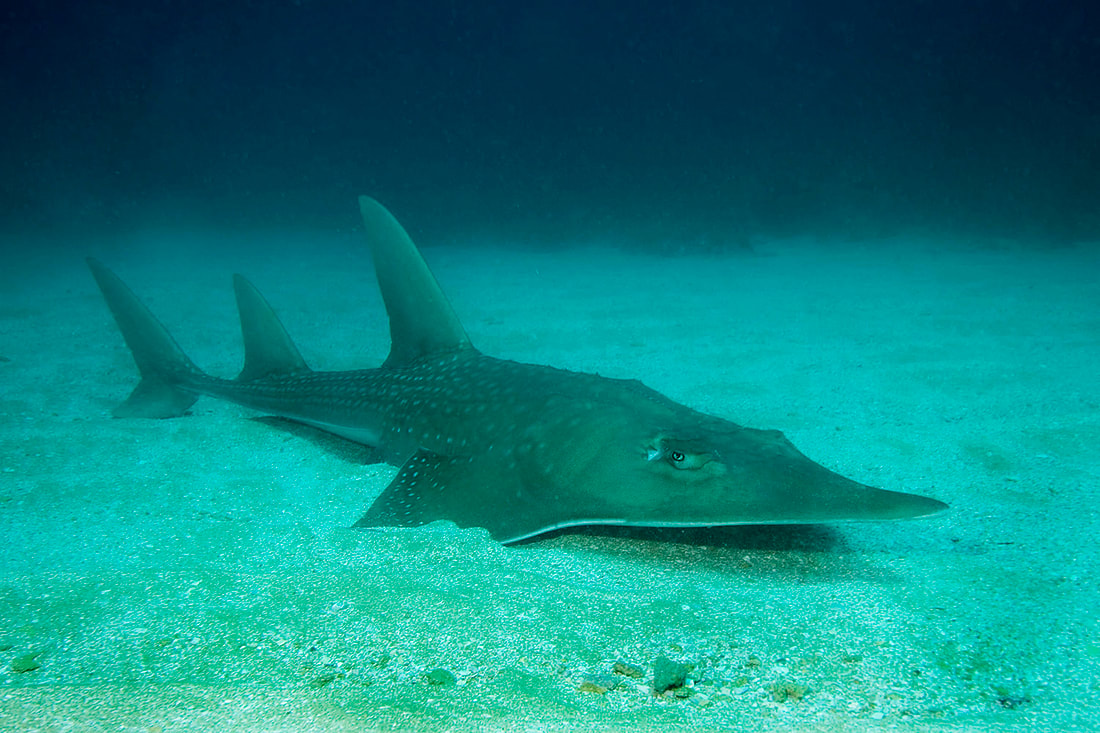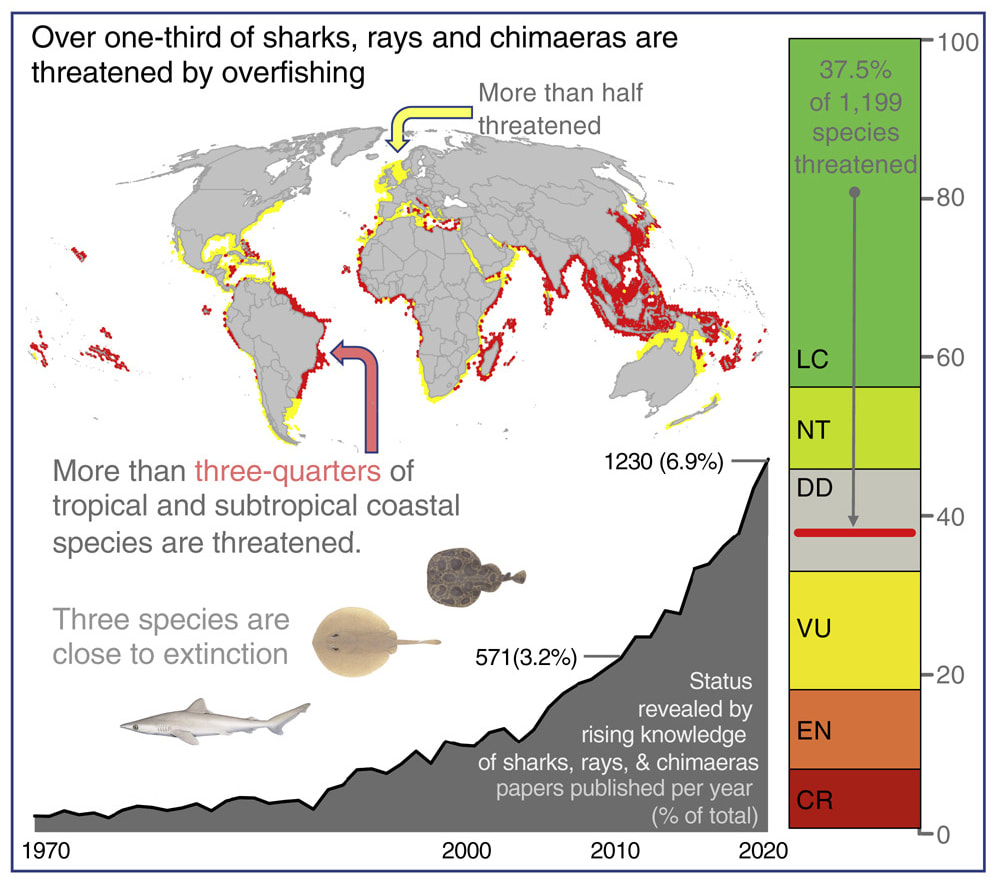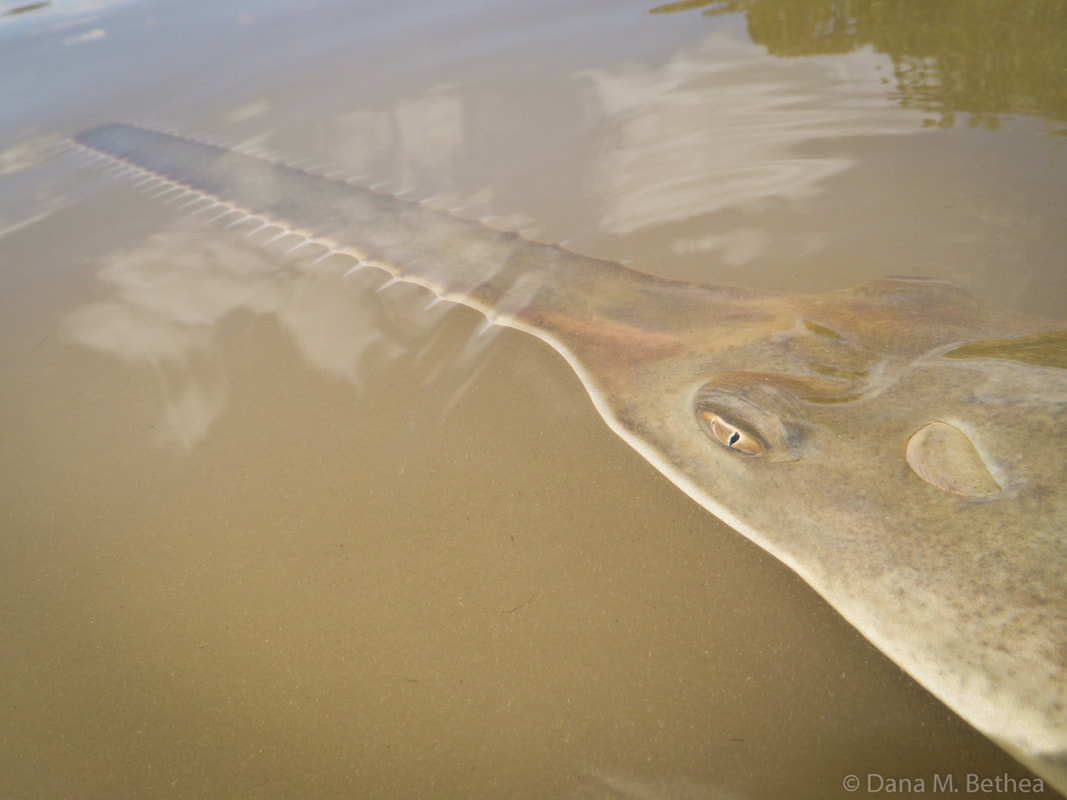|
Experts classify one-third of chondrichthyan fish species as threatened, urge conservation action
Specifically:
Rays are the most threatened of the three chondrichthyan fish groups:
"The results of this study are alarming. Overfishing continues to be the main threat to sharks, rays, and chimaeras and current fisheries management measures are simply not enough. In less than a decade we have gone from 25% to 37% of sharks, rays, and chimaeras considered threatened and having a high risk of extinction. This study was achieved through an unprecedented collaboration and engagement with IUCN SSC Shark Specialist Group members and non-members from around the world. This collaborative work to understand the status of species make me hopeful that we can work together and use our collective global resources and reach to work on reducing the impact of fishing on these species," said Dr Rima Jabado, Chair of the IUCN SSC Shark Specialist Group (SSG). “On one hand, we’re pleased that chondrichthyan science contributions have doubled since our first global analysis of this kind, allowing us to assess the status of many more species with greater confidence,” said Dr. Nicholas Dulvy, Professor at Simon Fraser University. “On the other hand, our study reveals an increasingly grim reality, with these species now making up one of the most threatened vertebrate lineages, second only to the amphibians in the risks they face. The widespread depletion of these fishes, particularly sharks and rays, jeopardizes the health of entire ocean ecosystems and food security for many nations around the globe.”
“The tropics host incredible shark and ray diversity, but too many of these inherently vulnerable species have been heavily fished for more than a century by a wide range of fisheries that remain poorly managed, despite countless commitments to improve,” said Dr. Colin Simpfendorfer, Adjunct Professor at James Cook University. “As a result, we fear we will soon confirm that one or more of these species has been driven to extinction from overfishing, a deeply troubling first for marine fishes. We will work to make this study a turning point in efforts to prevent any more irreversible losses and secure long-term sustainability.”
“Our analysis is alarming and yet offers some hope,” said Sonja Fordham, president of Shark Advocates International, a project of The Ocean Foundation. “We document significant rebuilding for several species of heavily fished skates, achieved through science-based limits. We have the frameworks, tools, and commitments to replicate this success across the globe, but time is running out for more and more shark and ray species. We urgently need governments, encouraged by citizens, to follow through with strict limits on unsustainable fishing and finally turn the tide for these extraordinary animals.” Core problemSharks, rays, and chimaeras are exceptionally susceptible to overfishing because they tend to grow slowly and produce few young, relative to other fish. Overfishing has far outpaced effective resource management for these species. Governments have fallen far short in fulfilling commitments under international treaties, primarily Regional Fisheries Management Organizations and the Convention on the International Trade of Endangered Species of Wild Fauna and Flora. Most governments have yet to prioritize chondrichthyan protection. Conservation action is urgently needed to prevent population collapses and myriad negative consequences for associated systems. So what?Chondrichthyan fishes are important to ecosystems and economies. Many species serve as important predators in marine food webs, transferring nutrients onto coral reefs from the surrounding ocean, as well as into deep sea from surface waters. Depletion of their populations not only risks extinction and ocean imbalance, but squanders opportunities for sustainable fishing, tourism, and food security over the long term. RemediesConservation action is urgently needed to reverse declining trends and prevent further extinction, ecosystem damage, and food insecurity. In particular, concrete limits on fishing based on scientific advice and the precautionary approach are urgently needed to minimize mortality of imperiled species and ensure sustainable exploitation of others. Area closures to further restrict fishing and protect habitats can augment catch limits and improve chances for recovery. Rebuilt populations are better positioned to withstand climate change. Immediate first steps include restricting landings, protecting important habitats, and implementing fisheries and wildlife treaty obligations. As a general rule, retention of shark and ray species categorized by IUCN as Endangered or Critically Endangered should be prohibited. Species classified as Near Threatened or Vulnerable may be able to sustain some fishing, if strictly limited to safe levels. Most chondrichthyan species would benefit from programs to minimize incidental catch and associated mortality. ReferenceNicholas K. Dulvy, Nathan Pacoureau, Cassandra L. Rigby, Riley A. Pollom, Rima W. Jabado, David A. Ebert, Brittany Finucci, Caroline M. Pollock, Jessica Cheok, Danielle H. Derrick, Katelyn B. Herman, C. Samantha Sherman, Wade J. VanderWright, Julia M. Lawson, Rachel H.L. Walls, John K. Carlson, Patricia Charvet, Kinattumkara K. Bineesh, Daniel Fernando, Gina M. Ralph, Jay H. Matsushiba, Craig Hilton-Taylor, Sonja V. Fordham, Colin A. Simpfendorfer. 2021. Overfishing drives over one-third of all sharks and rays toward a global extinction crisis. Current Biology. doi.org/10.1016/j.cub.2021.08.062. (sciencedirect.com/science/article/pii/S0960982221011982) AbstractThe scale and drivers of marine biodiversity loss are being revealed by the International Union for Conservation of Nature (IUCN) Red List assessment process. We present the first global reassessment of 1,199 species in Class Chondrichthyes—sharks, rays, and chimeras. The first global assessment (in 2014) concluded that one-quarter (24%) of species were threatened. Now, 391 (32.6%) species are threatened with extinction. When this percentage of threat is applied to Data Deficient species, more than one-third (37.5%) of chondrichthyans are estimated to be threatened, with much of this change resulting from new information. Three species are Critically Endangered (Possibly Extinct), representing possibly the first global marine fish extinctions due to overfishing. Consequently, the chondrichthyan extinction rate is potentially 25 extinctions per million species years, comparable to that of terrestrial vertebrates. Overfishing is the universal threat affecting all 391 threatened species and is the sole threat for 67.3% of species and interacts with three other threats for the remaining third: loss and degradation of habitat (31.2% of threatened species), climate change (10.2%), and pollution (6.9%). Species are disproportionately threatened in tropical and subtropical coastal waters. Science-based limits on fishing, effective marine protected areas, and approaches that reduce or eliminate fishing mortality are urgently needed to minimize mortality of threatened species and ensure sustainable catch and trade of others. Immediate action is essential to prevent further extinctions and protect the potential for food security and ecosystem functions provided by this iconic lineage of predators. AcknowledgmentsThe study was completed by the Global Shark Trends Project (GSTP), a collaboration of the IUCN SSC Shark Specialist Group (SSG), Simon Fraser University, James Cook University, and the Georgia Aquarium established with support from the Shark Conservation Fund (SCF) to assess the extinction risk for chondrichthyan fishes (sharks, rays, and chimaeras). The team engaged 322 experts from around the world to complete the 8-year long analysis.
Comments are closed.
|
Archives
May 2024
Categories
All
|



